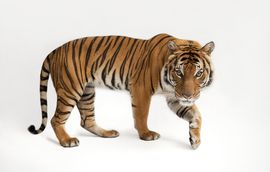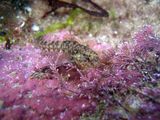
The largest snakes in the world, anacondas can grow to 550 pounds (227 kilograms).
Photograph by Ed George
Map

Green Anaconda Range
Fast Facts
- Type:
- Reptile
- Diet:
- Carnivore
- Average life span in the wild:
- 10 years
- Size:
- 20 to 30 ft (6 to 9 m)
- Weight:
- Up to 550 lbs (227 kg)
- Group name:
- Bed or knot
- Did you know?
- In mating, several competing males form a breeding ball around one female that can last up to four weeks.
- Size relative to a bus:
-

A member of the boa family, South America’s green anaconda is, pound for pound, the largest snake in the world. Its cousin, the reticulated python, can reach slightly greater lengths, but the enormous girth of the anaconda makes it almost twice as heavy.
Green anacondas can grow to more than 29 feet (8.8 meters), weigh more than 550 pounds (227 kilograms), and measure more than 12 inches (30 centimeters) in diameter. Females are significantly larger than males. Other anaconda species, all from South America and all smaller than the green anaconda, are the yellow, dark-spotted, and Bolivian varieties.
Anacondas live in swamps, marshes, and slow-moving streams, mainly in the tropical rain forests of the Amazon and Orinoco basins. They are cumbersome on land, but stealthy and sleek in the water. Their eyes and nasal openings are on top of their heads, allowing them to lay in wait for prey while remaining nearly completely submerged.
They reach their monumental size on a diet of wild pigs, deer, birds, turtles, capybara, caimans, and even jaguars. Anacondas are nonvenomous constrictors, coiling their muscular bodies around captured prey and squeezing until the animal asphyxiates. Jaws attached by stretchy ligaments allow them to swallow their prey whole, no matter the size, and they can go weeks or months without food after a big meal.
Female anacondas retain their eggs and give birth to two to three dozen live young. Baby snakes are about 2 feet (0.6 meters) long when they are born and are almost immediately able to swim and hunt. Their lifespan in the wild is about ten years.
Reptile Features
-

Snake Pictures
Slither in to meet some of the largest, deadliest, and fastest snakes in the world.
-

Swamp Men
Welcome to Billie Swamp Safari, where things get wild.
-

King Cobra
Come eye-to-eye with the king cobra, the longest venomous snake in the world. Learn why it is the reptile of choice for exotic snake charmers.
-

Alligator and Crocodile Pictures
Take a dip with more of these prehistoric giants. But watch yourself; they do bite.
Animals
-
Aardvark
-
 Adélie Penguin
Adélie Penguin
-
African Elephant
-
African Lion
-
 African Wild Dog
African Wild Dog
-
 Albatross
Albatross
-
 Alligator Snapping Turtle
Alligator Snapping Turtle
-
 Amazon Horned Frog
Amazon Horned Frog
-
 American Alligator
American Alligator
-
 American Bison
American Bison
-
 American Bullfrog
American Bullfrog
-
 American Crocodile
American Crocodile
-
 Ammonite
Ammonite
-
 Andean Condor
Andean Condor
-
 Anglerfish
Anglerfish
-
 Ankylosaurus Magniventris
Ankylosaurus Magniventris
-
Ant
-
 Arabian (Dromedary) Camel
Arabian (Dromedary) Camel
-
Arctic Fox
-
 Arctic Hare
Arctic Hare
-
 Arctic Skua
Arctic Skua
-
Armadillo
-
 Asian Elephant
Asian Elephant
-
 Asian Lion
Asian Lion
-
 Atlantic Bluefin Tuna
Atlantic Bluefin Tuna
-
 Atlantic Puffin
Atlantic Puffin
-
 Aye-Aye
Aye-Aye
-
 Baboon
Baboon
-
 Bactrian Camel
Bactrian Camel
-
Bald Eagle
-
 Baltimore Oriole
Baltimore Oriole
-
Beaver
-
 Beluga Whale
Beluga Whale
-
Bengal Tiger
-
 Bird of Paradise
Bird of Paradise
-
Black Bear
-
 Black-Footed Ferret
Black-Footed Ferret
-
 Black Mamba
Black Mamba
-
 Black Rhinoceros
Black Rhinoceros
-
 Blacktip Shark
Blacktip Shark
-
Black Widow Spider
-
 Bluebird
Bluebird
-
 Blue Crab
Blue Crab
-
 Blue-Footed Booby
Blue-Footed Booby
-
 Blue Jay
Blue Jay
-
 Blue Marlin
Blue Marlin
-
Blue Whale
-
 Boa Constrictor
Boa Constrictor
-
Bobcat
-
Bottlenose Dolphin
-
 Box Jellyfish
Box Jellyfish
-
 Brachychampsa Montana
Brachychampsa Montana
-
 Brown Bear
Brown Bear
-
Bull Shark
-
 Burmese Python
Burmese Python
-
 Butterflyfish
Butterflyfish
-
 California Condor
California Condor
-
 California Sea Lion
California Sea Lion
-
 Canada Goose
Canada Goose
-
 Cane Toad
Cane Toad
-
 Canvasback
Canvasback
-
 Caribou
Caribou
-
 Carolina Wren
Carolina Wren
-
Cheetah
-
Chimpanzee
-
 Chipmunk
Chipmunk
-
 Cicada
Cicada
-
 Clouded Leopard
Clouded Leopard
-
 Clown Anemonefish
Clown Anemonefish
-
 Coelacanth
Coelacanth
-
 Common Earthworm
Common Earthworm
-
 Common Loon
Common Loon
-
 Common Octopus
Common Octopus
-
 Common Sandpiper
Common Sandpiper
-
 Common Vampire Bat
Common Vampire Bat
-
 Common Wombat
Common Wombat
-
 Coral
Coral
-
 Cottontail Rabbit
Cottontail Rabbit
-
Coyote
-
 Cretoxyrhina Mantelli
Cretoxyrhina Mantelli
-
 Cuban Screech Owl
Cuban Screech Owl
-
 Cubera Snapper
Cubera Snapper
-
 Deer Tick
Deer Tick
-
 Devil Frog
Devil Frog
-
 Dingo
Dingo
-
 Dog Snapper
Dog Snapper
-
 Dolichorhynchops Osborni
Dolichorhynchops Osborni
-
 Domestic Cat
Domestic Cat
-
 Domestic Dog
Domestic Dog
-
 Draco Lizard
Draco Lizard
-
 Dugong
Dugong
-
 Eastern Coral Snake
Eastern Coral Snake
-
 Eastern Diamondback Rattlesnake
Eastern Diamondback Rattlesnake
-
 Eastern Gray Kangaroo
Eastern Gray Kangaroo
-
 Egyptian Giant Solpugid (Camel Spider)
Egyptian Giant Solpugid (Camel Spider)
-
 Electric Eel
Electric Eel
-
 Elephant Seal
Elephant Seal
-
 Elk
Elk
-
Emperor Penguin
-
 Fennec Fox
Fennec Fox
-
Firefly (Lightning Bug)
-
 Flying Fish
Flying Fish
-
 Flying Snake
Flying Snake
-
 Fossa
Fossa
-
 Frilled Lizard
Frilled Lizard
-
 Fur Seal
Fur Seal
-
 Galápagos Tortoise
Galápagos Tortoise
-
 Gelada
Gelada
-
 Gentoo Penguin
Gentoo Penguin
-
 Geographic Cone Snail
Geographic Cone Snail
-
 Giant Anteater
Giant Anteater
-
 Giant Clam
Giant Clam
-
 Giant Pacific Octopus
Giant Pacific Octopus
-
Giant Panda
-
Giant River Otter
-
 Giant Squid
Giant Squid
-
 Gibbon
Gibbon
-
 Gila Monster
Gila Monster
-
Giraffe
-
 Golden Cowrie
Golden Cowrie
-
 Golden Eagle
Golden Eagle
-
 Golden Jellyfish
Golden Jellyfish
-
 Golden Lion Tamarin
Golden Lion Tamarin
-
 Golden Poison Dart Frog
Golden Poison Dart Frog
-
 Gray Whale
Gray Whale
-
 Great Blue Heron
Great Blue Heron
-
 Great Egret
Great Egret
-
 Greater Flamingo
Greater Flamingo
-
 Greater Rhea
Greater Rhea
-
 Great Horned Owl
Great Horned Owl
-
Great White Shark
-
 Green Anaconda
Green Anaconda
-
 Green Basilisk Lizard
Green Basilisk Lizard
-
 Green-Eyed Tree Frog
Green-Eyed Tree Frog
-
 Green Iguana
Green Iguana
-
Green Sea Turtle
-
Grizzly Bear
-
 Groundhog
Groundhog
-
Hammerhead Shark
-
 Harbor Porpoise
Harbor Porpoise
-
 Harp Seal
Harp Seal
-
 Hawaiian Monk Seal
Hawaiian Monk Seal
-
 Hawksbill Sea Turtle
Hawksbill Sea Turtle
-
 Hedgehog
Hedgehog
-
 Henodus Chelyops
Henodus Chelyops
-
 Hesperornis Regalis
Hesperornis Regalis
-
 Hippopotamus
Hippopotamus
-
 Honeybee
Honeybee
-
 Horned Toad (Short-Horned Lizard)
Horned Toad (Short-Horned Lizard)
-
Hornet
-
Horse
-
 Howler Monkey
Howler Monkey
-
 Humpback Whale
Humpback Whale
-
 Impala
Impala
-
 Indian Rhinoceros
Indian Rhinoceros
-
 Ivory-Billed Woodpecker
Ivory-Billed Woodpecker
-
 Jackrabbit
Jackrabbit
-
Jaguar
-
 Kemp's Ridley Sea Turtle
Kemp's Ridley Sea Turtle
-
Killer Whale (Orca)
-
King Cobra
-
 King Vulture
King Vulture
-
 Kinkajou
Kinkajou
-
Koala
-
Komodo Dragon
-
 Krill
Krill
-
Ladybug
-
 Laughing Kookaburra
Laughing Kookaburra
-
 Leafy and Weedy Sea Dragon
Leafy and Weedy Sea Dragon
-
Leatherback Sea Turtle
-
Leopard
-
 Leopard Seal
Leopard Seal
-
 Leptoceratops Gracilis
Leptoceratops Gracilis
-
 Lesothosaurus Diagnosticus
Lesothosaurus Diagnosticus
-
 Lionfish
Lionfish
-
 Little Red Flying-Fox
Little Red Flying-Fox
-
 Llama
Llama
-
 Lobster
Lobster
-
 Locust
Locust
-
 Loggerhead Sea Turtle
Loggerhead Sea Turtle
-
Lynx
-
Macaw
-
 Madagascar Hissing Cockroach
Madagascar Hissing Cockroach
-
 Mallard Duck
Mallard Duck
-
 Manatee
Manatee
-
 Mandrill
Mandrill
-
 Marine Iguana
Marine Iguana
-
 Matschie's Tree Kangaroo
Matschie's Tree Kangaroo
-
 Meerkat
Meerkat
-
 Meller's Chameleon
Meller's Chameleon
-
 Mexican Axolotl
Mexican Axolotl
-
 Mola (Sunfish)
Mola (Sunfish)
-
 Mole Rat
Mole Rat
-
 Monarch Butterfly
Monarch Butterfly
-
 Mongoose
Mongoose
-
 Mononykus Olecranus
Mononykus Olecranus
-
 Moose
Moose
-
 Mosquito
Mosquito
-
 Mountain Goat
Mountain Goat
-
Mountain Lion
-
 Mouse Lemur
Mouse Lemur
-
 Mudpuppy
Mudpuppy
-
 Musk-Ox
Musk-Ox
-
 Narwhal
Narwhal
-
 Nile Crocodile
Nile Crocodile
-
 North American River Otter
North American River Otter
-
 Northern Leopard Frog
Northern Leopard Frog
-
 Nudibranch
Nudibranch
-
 Nurse Shark
Nurse Shark
-
 Nutria
Nutria
-
Ocelot
-
 Olive Ridley Sea Turtle
Olive Ridley Sea Turtle
-
 Opossum
Opossum
-
 Orangutan
Orangutan
-
 Oriental Fire-Bellied Toad
Oriental Fire-Bellied Toad
-
 Osprey
Osprey
-
 Ostrich
Ostrich
-
 Oyster
Oyster
-
 Ozark Big-Eared Bat
Ozark Big-Eared Bat
-
 Pachycephalosaurus Wyomingensis
Pachycephalosaurus Wyomingensis
-
 Parrot
Parrot
-
 Parrot Fish
Parrot Fish
-
Peacock
-
 Pelican
Pelican
-
 Peregrine Falcon
Peregrine Falcon
-
 Pileated Woodpecker
Pileated Woodpecker
-
 Platecarpus
Platecarpus
-
 Platypus
Platypus
-
Poison Dart Frog
-
Polar Bear
-
Porcupine
-
 Portuguese Man-of-War
Portuguese Man-of-War
-
 Prairie Dog
Prairie Dog
-
Praying Mantis
-
 Proboscis Monkey
Proboscis Monkey
-
 Pronghorn
Pronghorn
-
 Protosphyraena
Protosphyraena
-
 Protostega Gigas
Protostega Gigas
-
 Przewalski's Horse
Przewalski's Horse
-
Pufferfish
-
 Queen Angelfish
Queen Angelfish
-
 Quetzal
Quetzal
-
Raccoon
-
 Rainbow Trout
Rainbow Trout
-
 Raven
Raven
-
 Red Crab
Red Crab
-
 Red-Eyed Tree Frog
Red-Eyed Tree Frog
-
 Red-Footed Booby
Red-Footed Booby
-
Red Fox
-
 Red Kangaroo
Red Kangaroo
-
 Red Leaf Monkey
Red Leaf Monkey
-
Red Panda
-
 Red-Tailed Hawk
Red-Tailed Hawk
-
 Red Uakari
Red Uakari
-
 Rhesus Monkey
Rhesus Monkey
-
 Right Whale
Right Whale
-
 Ringed Seal
Ringed Seal
-
 Ring-Necked Pheasant
Ring-Necked Pheasant
-
 Ring-Tailed Lemur
Ring-Tailed Lemur
-
 Rockhopper Penguin
Rockhopper Penguin
-
 Rocky Mountain Bighorn Sheep
Rocky Mountain Bighorn Sheep
-
 Ruby-Throated Hummingbird
Ruby-Throated Hummingbird
-
 Sailfish
Sailfish
-
 Saltwater Crocodile
Saltwater Crocodile
-
 Sandhill Crane
Sandhill Crane
-
 Sand Tiger Shark
Sand Tiger Shark
-
 Scarab
Scarab
-
 Scorpion
Scorpion
-
 Sea Anemone
Sea Anemone
-
 Sea Cucumber
Sea Cucumber
-
Seahorse
-
 Sea Otter
Sea Otter
-
Siberian Tiger
-
 Sifaka
Sifaka
-
 Skunk
Skunk
-
 Sloth Bear
Sloth Bear
-
 Snow Goose
Snow Goose
-
Snow Leopard
-
 Snowshoe Hare
Snowshoe Hare
-
Snowy Owl
-
 Sockeye Salmon
Sockeye Salmon
-
 Spectacled Bear
Spectacled Bear
-
 Sperm Whale
Sperm Whale
-
Spider Monkey
-
 Spotted Hyena
Spotted Hyena
-
 Spotted Salamander
Spotted Salamander
-
 Spring Peeper
Spring Peeper
-
 Squirrel
Squirrel
-
 Starfish (Sea Star)
Starfish (Sea Star)
-
 Steller Sea Lion
Steller Sea Lion
-
 Steller's Sea Eagle
Steller's Sea Eagle
-
 Stick Insect
Stick Insect
-
Stingray
-
 Styxosaurus Snowii
Styxosaurus Snowii
-
 Sumatran Rhinoceros
Sumatran Rhinoceros
-
 Sun Bear
Sun Bear
-
 Tapir
Tapir
-
 Tarantula
Tarantula
-
 Tasmanian Devil
Tasmanian Devil
-
 Thescelosaurus Neglectus
Thescelosaurus Neglectus
-
 Thick-Billed Murre
Thick-Billed Murre
-
 Thomson's Gazelle
Thomson's Gazelle
-
 Three-Toed Sloth
Three-Toed Sloth
-
 Tiger Salamander
Tiger Salamander
-
 Tiger Shark
Tiger Shark
-
Toucan
-
 Triceratops Horridus
Triceratops Horridus
-
 Triggerfish
Triggerfish
-
 Troodon Formosus
Troodon Formosus
-
 Tundra Swan
Tundra Swan
-
 Tusotheuthis Longa
Tusotheuthis Longa
-
 Two-Toed Sloth
Two-Toed Sloth
-
 Tylosaurus Proriger
Tylosaurus Proriger
-
 Tyrannosaurus Rex
Tyrannosaurus Rex
-
 Velociraptor Mongoliensis
Velociraptor Mongoliensis
-
 Wallaby
Wallaby
-
 Wallace's Flying Frog
Wallace's Flying Frog
-
 Walrus
Walrus
-
 Warthog
Warthog
-
 Warty Newt
Warty Newt
-
Wasp
-
 Water Buffalo
Water Buffalo
-
 Web-Footed Gecko
Web-Footed Gecko
-
 Weddell Seal
Weddell Seal
-
 Western Lowland Gorilla
Western Lowland Gorilla
-
Whale Shark
-
 White-Eared Kob
White-Eared Kob
-
 White Rhinoceros
White Rhinoceros
-
White-Tailed Deer
-
 Whooping Crane
Whooping Crane
-
 Wildebeest
Wildebeest
-
 Wild Turkey
Wild Turkey
-
Wolf
-
Wolverine
-
 Wood Stork
Wood Stork
-
 Xiphactinus Audax
Xiphactinus Audax
-
Zebra
Advertisement
Photos
-

Pictures: Tiger Subspecies
Scientists estimate only about 3,000 wild tigers are left in the entire world. Meet the subspecies and see what threats each is facing.
Special Ad Section
Animal News
From the Magazine
-

The Surprising Lives of Lions
In case you missed it: See these breathtaking videos and photos from inside a wild Serengeti pride.
-

Gannets Pictures
Champion divers but clumsy landers, doting parents but hostile neighbors—northern gannets abound in contradictions.




























